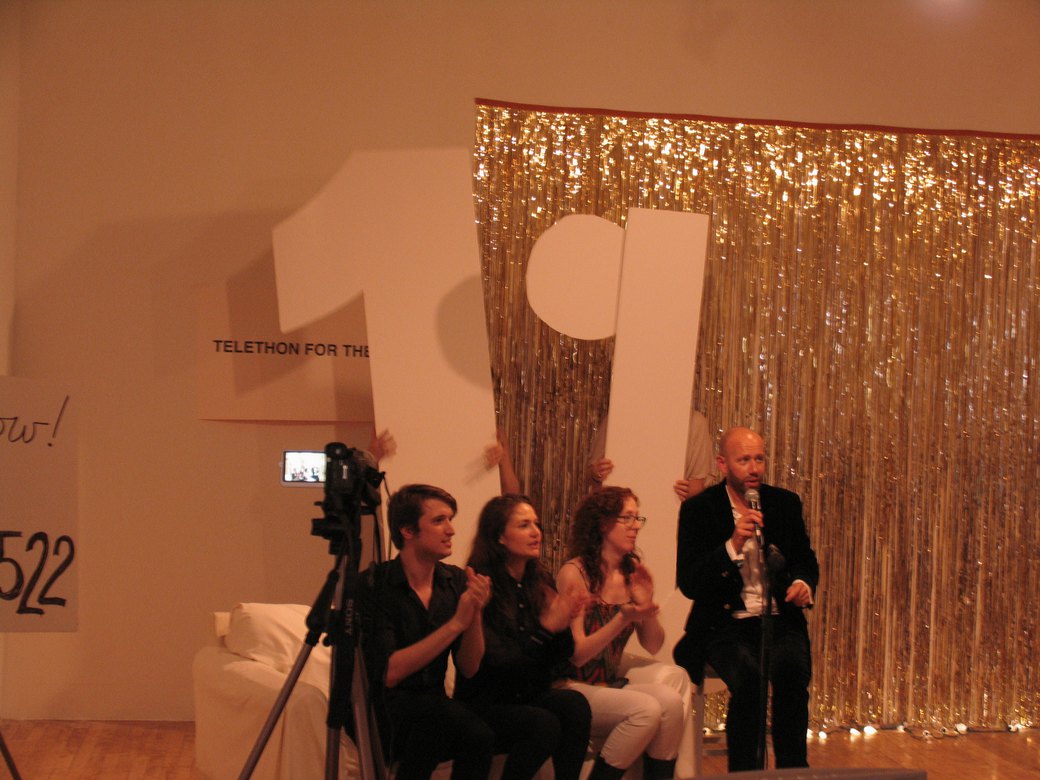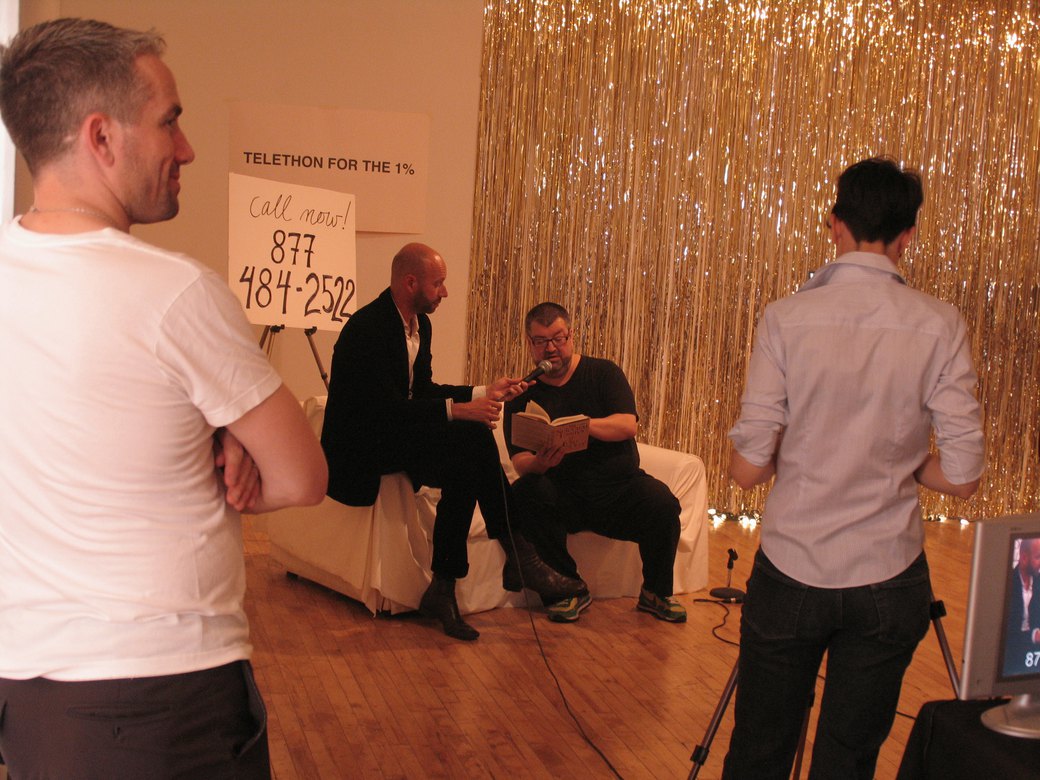By Sean Alday

A collective calling themselves FIPCA are having a Telethon For the 1%.
“We’re trying to raise awareness for the plight of the 1%.” William Powhida tells me.
I’ve stumbled upon a 12 hour performance piece in Momenta Art staged alongside Mark Tribe’s solo exhibit Rare Earth [absolutely innocent of the performance, but culpable in photos].
Fittingly and unwittingly, the works are priced as though it were a thrift shop for the 1% where you might find a treasure among the fake-gold-foil-baby-Jesus paintings.
I learned on that day that of the wealthiest 1% there are 99% percent that need financial assistance to purchase contemporary art. Many of them cannot afford to worry about calves (with actual golden hooves) immersed in chemicals nor a seat for a personal assistant to bid on that Munch in May.

And really, who among them would want to be seen or photographed in the bargain bin Bushwick art galleries? Even if they were just perusing Powhida prints for grandma since she can’t tell the difference even with her glasses on. No, leave that to the intrepid reporters of Hyperallergic, the Holland Cotters, and compass-sporting video-reporting of the James Kalm report.
According to Ed Jaster – senior vice-president of Heritage Auction Galleries:
“Art galleries are limited in their offerings and client base. Heritage is an $850 million business, and there aren’t a lot of $850 million art galleries.”

Bushwick Basel? Call when you have some skulls to sell.
I once told William Powhida that I wanted to talk to him because people tend to think of him as an asshole. Here is a quick discussion we had:
Sean: How many of your patrons are in the 1%?
William: I’d say about 95% of them.
Sean: So how much did you make last year on art sales?
William: Well, I don’t know precisely but, a rough estimate based on quarters puts the amount at around $30,000 for the year. Which is not close to a middle class lifestyle.
Sean: Is there a 1% among artists?
William: Absolutely. Very few make most of the big sales. It’s a star system geared toward taste-based connoisseurs.
Sean: What do you do to supplant your income?
William: I teach high school students. Many artists that I know teach in order to support their work.
Sean: What do you do to keep from being just another person with an opinion? If you are in a similar boat as artists that you know, how do you support your views?
William: I’ve donated work to Momenta, Arts In Bushwick, Artist Alliance, a group called Wage Artists who is working to get a living wage for artists.
Sean: What advice do you have for artists?
William: What’s your goal? Do you want to be successful in the commercial system? Do you want time to make work? To exhibit your work?
Figure out what your ideal level of success is.
Sean: What’s your ideal level of success?
William: To be able to continue making work and talk about the art world.
Sean: You have a reputation as someone who bites the hand that feeds him. Tell me this, is the hand tastier than what’s being offered?
William: [laughs] Well, the 1% has particularly soft hands. I’ve nibbled on a pinky here and there and it’s very tender. Ask me that again when I make it to the tenderloin section.
We talked a few more minutes before he had to run back inside to play ringmaster of the 12 hour circus. This was a wholeheartedly public access affair, complete with odd transitions, someone constantly tweaking the camera angles and vinyl records providing the soundtrack.

“YOU’RE SCARED TO ANSWER MY QUESTION!” Jonathan Grossmalerman thundered at James Kalm on a couch.
“We don’t want pledges, we want hard cash!” Kalm responed as a phone number flashed across the bottom of the broadcast.
I stayed for a bit sipping on Miller High Life and charging my electronic cigarette. What ran through my mind was not answering questions. It was asking them. I don’t know if we are too scared to ask questions of people. It seems ridiculous to not ask what this actually accomplished, we should all be aware of the madness by now.
Yet, had this not happened, with all of its awkwardness and sweaty foreheads, I don’t know that I would have ever written anything containing the phrase “1%.”
In one moment of satire, Christian Viveros-Faune said something that is both perfectly and viscerally true: “The reward of art is intoxication.”

Update 1: “We were all engaged and hopefully in some way, implicated. I’d like to think that established artists should probably be thinking more broadly about their relationship to the 1% and patronage. You know, my quote about what percent of my patrons are 1% would go way down if I factored in everyone who bought a 20×200 print. Probably make the 1% about 5% of my collector base, but that’s if we consider a $20 purchase collecting art.”
-William Powhida
Update 2: “I’m extremely pleased with the outpouring of support we received. 12 hours straight is a very long time to entertain and I’d really like to thank cocaine for making that possible.
“I’d also like to thank the people who donated the cocaine. And to the bastards who think we’re being facetious about this whole thing. I ask you, if you’re in trouble, I mean really in trouble, like you hit someone with your car. Do you call your poor friend with no connections?
“I didn’t think so.
“Support the 1%. They sometimes buy art. “
-Jonathan Grossmalerman


